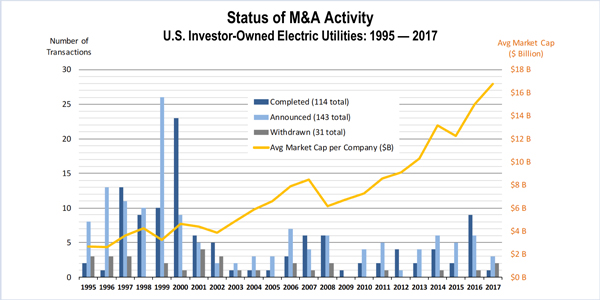By Michael Brooks
NEW YORK — The Edison Electric Institute celebrated the passage of the Tax Cuts and Jobs Act at its annual briefing to Wall Street analysts last week, touting how it had worked to preserve interest deductibility for the corporate debt of the country’s 49 investor-owned utilities.
EEI President Thomas Kuhn said the original bill did away with interest deductibility and that Speaker of the House Paul Ryan told him he was reluctant to make an exception for the IOUs. The trade association then developed an analysis showing how maintaining the deductibility “would help our consumers, help us build infrastructure … and would be a net positive for the Treasury,” Kuhn told more than 100 analysts on Wednesday.
The result: The utilities industry was only one of two, along with agriculture, to receive the exception.
Under the new law, most corporations will only be able to deduct interest expenses of up to 30% of their earnings, which are now taxed at a flat 21%. The provision is meant to discourage excessive borrowing and keeping large amounts of debt on the books.
But being “the most capital-intensive industry in the United States … maintaining ready access to capital markets and keeping the cost of capital low are important to meeting our investment needs,” EEI said.
Kuhn said EEI is now working to clarify that the exception applies to utilities’ operating companies, not just their holding companies. Because the tax bill was signed into law on Dec. 22, the association is also seeking clarification on if the new rules on bonus depreciation — which allow businesses to deduct 100% of the cost of certain business assets, up from 50% — apply to the fourth quarter of 2017.
The clarifications could from the Treasury Department or Internal Revenue Service, or in technical corrections bill later this year.
Political Outlook
Tax reform was the top priority for EEI last year, and it ended up paying off, Kuhn said. (See EEI Pledges to Fight Elimination of Tax Deductions.)
Based on President Trump’s State of the Union Address on Jan. 30, and statements from Republican Congressional leaders, he said, infrastructure will be theme of 2018.
One thing EEI is not seeking out in infrastructure legislation is federal funding.
“We don’t need federal money, which is a good thing,” Kuhn said, given that “there’s not going to be a ton of federal money to pass around” under the new law.
Instead, said Phil Moeller, executive vice president of business operations and regulatory affairs, EEI will seek policies that increase certainty for building transmission projects, such as more efficient permitting processes, increased cooperation between state and federal regulators, and reforms to return on equity calculations.
The former FERC commissioner repeated the association’s positions the next day in D.C. before a hearing of the Senate Energy and Natural Resources Committee on energy infrastructure.
Moeller stressed the need for “cooperative federalism, so that one state doesn’t deny the benefits [of a project] to the citizens and customers of many other states.” He noted that regulatory deadlines for different jurisdictions are not aligned, creating delays for projects.
FERC can change much on its own, Moeller told both analysts and senators, but legislation would provide utilities more certainty. Much of EEI’s concerns would be addressed in a bipartisan energy bill pending before the Senate, Moeller said. That bill, the Energy and Natural Resources Act of 2017, is similar to a bill that passed the Senate 85-12 in 2016 but could not make it past the House of Representatives before Congress’ session ended.
Kuhn spent a portion of his opening remarks on the upcoming midterm elections, saying the association is monitoring them closely. He noted the unusually high number of representatives retiring at the end of their terms: 55, 38 of which are Republican. Democrats need to pick up 25 seats to gain control of the chamber, which Kuhn said there is a good chance of happening.
Return on Equity
EEI is particularly focused on the issue of calculating ROEs. The D.C. Circuit Court of Appeals threw out FERC’s two-step discounted flow methodology in April last year, saying the commission had not justified how it set the rates for a group of New England transmission owners. (See Court Rejects FERC ROE Order for New England.)
EEI published a whitepaper prepared by ScottMadden on the issue, which Moeller said he hopes will help guide FERC.
Moeller noted that he was on the commission that created the process in 2014, saying it is a complex and difficult issue that took months to figure out. He expects the new commission — Cheryl LaFleur is the only remaining commissioner who voted on the ROE ruling — to take its time to address the court’s concerns, but that a new rule would come out before the end of the year.
“The good news is they have to deal with it based on the remand from the D.C. Circuit,” Moeller said. The other good news, he said, is that the commissioners and their staffs are very knowledgeable of the issue.
“I think we have a chairman in Kevin McIntyre who not only has the experience but also the intelligence and, importantly, the temperament to run an agency that is increasingly in the public view,” Moeller said.



